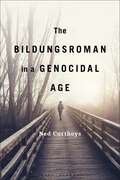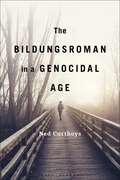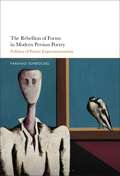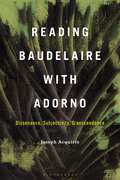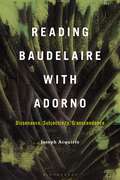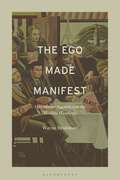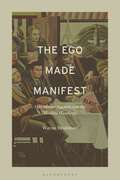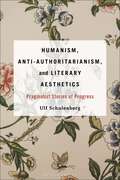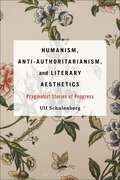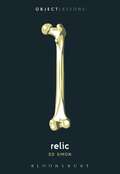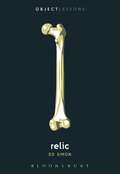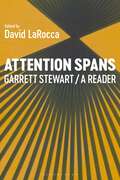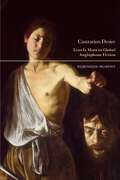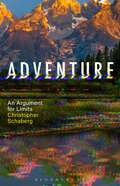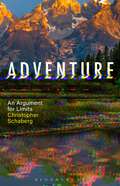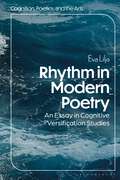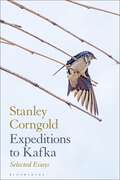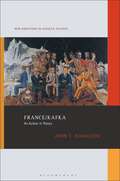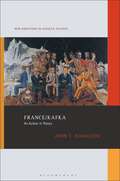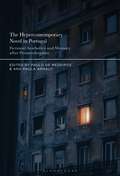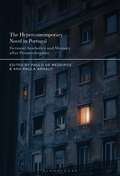- Table View
- List View
The Bildungsroman in a Genocidal Age
by Dr. Ned CurthoysThe Bildungsroman in a Genocidal Age argues that the humanist ideal of Bildung, the cultivation of the potentialities of the self through self-reflection, travel, and varied social intercourse, has been revitalized in an age of genocidal violence. It examines the Bildungsroman as a flourishing intermedial genre encompassing contemporary historical fiction, historical feature films, and children's and YA literature. Analysing a number of highly influential novels and films about the Holocaust and World War II (WWII), the book argues that the narrative strategies of the Bildungsroman, which includes a swerve away from 'home' and its parochialism and moral certainties, has contributed to shaping audience perceptions of traumatic histories and their ethical implications in the twenty-first century. The Bildungsroman in a Genocidal Age examines some of the most keenly discussed, and controversial historical fictions of recent decades including The Remains of the Day (1989), The Kindly Ones (2006, English trans. 2009), The Boy in the Striped Pyjamas (2006), and Margarethe von Trotta's biopic Hannah Arendt (2012). It argues that in portraying a protagonist who defers or refuses a prescribed social destiny, these novels and films are sensitive to the 'Eichmann problematic' of the 'banality of evil' as formulated by Hannah Arendt. These Bildungsromane, the study suggests, are designed to address the problem of the social reproduction of normative, unimaginative, and conformist mindsets that can enable totalitarian politics and genocidal policies.
The Bildungsroman in a Genocidal Age
by Dr. Ned CurthoysThe Bildungsroman in a Genocidal Age argues that the humanist ideal of Bildung, the cultivation of the potentialities of the self through self-reflection, travel, and varied social intercourse, has been revitalized in an age of genocidal violence. It examines the Bildungsroman as a flourishing intermedial genre encompassing contemporary historical fiction, historical feature films, and children's and YA literature. Analysing a number of highly influential novels and films about the Holocaust and World War II (WWII), the book argues that the narrative strategies of the Bildungsroman, which includes a swerve away from 'home' and its parochialism and moral certainties, has contributed to shaping audience perceptions of traumatic histories and their ethical implications in the twenty-first century. The Bildungsroman in a Genocidal Age examines some of the most keenly discussed, and controversial historical fictions of recent decades including The Remains of the Day (1989), The Kindly Ones (2006, English trans. 2009), The Boy in the Striped Pyjamas (2006), and Margarethe von Trotta's biopic Hannah Arendt (2012). It argues that in portraying a protagonist who defers or refuses a prescribed social destiny, these novels and films are sensitive to the 'Eichmann problematic' of the 'banality of evil' as formulated by Hannah Arendt. These Bildungsromane, the study suggests, are designed to address the problem of the social reproduction of normative, unimaginative, and conformist mindsets that can enable totalitarian politics and genocidal policies.
The Rebellion of Forms in Modern Persian Poetry: Politics of Poetic Experimentation
by Dr. Farshad SonboldelAn analysis of the aesthetic, cultural and political aspects of alternative poetic movements and individual poets in three periods: the Constitutional Revolution (1900–1920), the post-constitutional era (1920–1940), and the ascendency of modernism (1940–1960). Farshad Sonboldel shines new light on the history of modern Persian poetry by re-imagining the roles that the aesthetic experimentations of alternative poets played in different phases of the literary revolution in modern Persian poetry. Dominant narratives portray modern Persian poetry as a gradual, rational, and moderate change in the classical regime of aesthetics as well as a response to – and reflection of – cultural and socio-political changes within Iranian society. They also disregard the significance of radical experiments by alternative poets and undervalue the part they played in the initiation and progress of the so-called "literary revolution." These mainstream narratives minimize the socio-political engagement of literary works with the direct reflection of the social reality, and thus neglect the way many alternative poems struggle with socio-political issues through deconstructing the old and constructing new aesthetic systems.Each chapter of The Rebellion of Forms in Modern Persian Poetry is centred around poems chosen for their potential to showcase notable experiments of pioneer movements and individuals in each given period. Examining the formal and thematic aspects of these poems, this book reformulates the story of modern Persian poetry and unravels the relationship between radical aesthetic changes in the practice of poetry and resistance against political and cultural domination in society.
The Rebellion of Forms in Modern Persian Poetry: Politics of Poetic Experimentation
by Dr. Farshad SonboldelAn analysis of the aesthetic, cultural and political aspects of alternative poetic movements and individual poets in three periods: the Constitutional Revolution (1900–1920), the post-constitutional era (1920–1940), and the ascendency of modernism (1940–1960). Farshad Sonboldel shines new light on the history of modern Persian poetry by re-imagining the roles that the aesthetic experimentations of alternative poets played in different phases of the literary revolution in modern Persian poetry. Dominant narratives portray modern Persian poetry as a gradual, rational, and moderate change in the classical regime of aesthetics as well as a response to – and reflection of – cultural and socio-political changes within Iranian society. They also disregard the significance of radical experiments by alternative poets and undervalue the part they played in the initiation and progress of the so-called "literary revolution." These mainstream narratives minimize the socio-political engagement of literary works with the direct reflection of the social reality, and thus neglect the way many alternative poems struggle with socio-political issues through deconstructing the old and constructing new aesthetic systems.Each chapter of The Rebellion of Forms in Modern Persian Poetry is centred around poems chosen for their potential to showcase notable experiments of pioneer movements and individuals in each given period. Examining the formal and thematic aspects of these poems, this book reformulates the story of modern Persian poetry and unravels the relationship between radical aesthetic changes in the practice of poetry and resistance against political and cultural domination in society.
Reading Baudelaire with Adorno: Dissonance, Subjectivity, Transcendence
by Joseph AcquistoReading Baudelaire with Adorno examines Charles Baudelaire's oeuvre – including verse poems, prose poems, and critical writings – in dialogue with the aesthetic theory of Theodor Adorno, for whom the autonomy of the artwork critically resists any attempt to view it merely as a product of its socio-historic context. Joseph Acquisto analyzes Baudelairean duality through the lens of dissonance, arguing that the figure of the subject as a “dissonant chord” provides a gateway to Baudelaire's reconfiguration of subjectivity and objectivity in both esthetic and epistemological terms. He argues that Baudelaire's dissonance depends on older models of subjectivity in order to define itself via the negation of romantic conceptions of a unified lyric subject in favor of one constituted simultaneously as subject and object.This new understanding of subjectivity reconfigures our relationship to the work of art, which will always surpass conceptual attempts to know it fully. Acquisto offers a fresh take on some familiar themes in Baudelaire's work. Dissonant subjectivity in Baudelaire, rather than cancelling esthetic transcendence, points to a different way forward that depends on a new and dialectical relation of subject and object.
Reading Baudelaire with Adorno: Dissonance, Subjectivity, Transcendence
by Joseph AcquistoReading Baudelaire with Adorno examines Charles Baudelaire's oeuvre – including verse poems, prose poems, and critical writings – in dialogue with the aesthetic theory of Theodor Adorno, for whom the autonomy of the artwork critically resists any attempt to view it merely as a product of its socio-historic context. Joseph Acquisto analyzes Baudelairean duality through the lens of dissonance, arguing that the figure of the subject as a “dissonant chord” provides a gateway to Baudelaire's reconfiguration of subjectivity and objectivity in both esthetic and epistemological terms. He argues that Baudelaire's dissonance depends on older models of subjectivity in order to define itself via the negation of romantic conceptions of a unified lyric subject in favor of one constituted simultaneously as subject and object.This new understanding of subjectivity reconfigures our relationship to the work of art, which will always surpass conceptual attempts to know it fully. Acquisto offers a fresh take on some familiar themes in Baudelaire's work. Dissonant subjectivity in Baudelaire, rather than cancelling esthetic transcendence, points to a different way forward that depends on a new and dialectical relation of subject and object.
The Ego Made Manifest: Max Stirner, Egoism, and the Modern Manifesto
by Dr. Wayne BradshawFrom Karl Marx to Wyndham Lewis, this book examines Max Stirner's influence on the modern manifesto.Max Stirner has long proven to be an elusive figure at the fringes of 19th-century German idealism. He has been portrayed as the father of the philosophical dead end that was egoistic anarchism: a withered branch of an ineffectual movement, remembered largely because of its suggestion that crime was a valid form of revolutionary action. From this perspective, egoists subscribed to extreme forms of anarchism and defended acts of theft, assault, and even murder; egoism only held lasting appeal to rebels, nihilists, and criminals; and Stirner's ideas could – and should – be consigned to the dustbin of history accordingly. The Ego Made Manifest argues that many of the accepted truisms about Stirner and his reception are false and that his contribution to modernist and avant-garde manifesto-writing traditions has been overlooked. Beginning with his influence on Marx's Communist Manifesto, Wayne Bradshaw reinserts Stirner into the history of manifestos that not only rebelled against tradition but sought to take ownership of history, culture, and people's minds. This study documents the trajectory of Stirner's reception from mid-19th-century Germany to his rediscovery by German and American readers almost 50 years later, and from his popularity among manifesto writers in fin de siècle Paris to the birth of Italian Futurism. Finally, it considers how American and British interest in egoism helped inspire Vorticism's satirical approach to revolt, and how, in an age of extremism, Stirner's ideas continue to haunt the modern mind.
The Ego Made Manifest: Max Stirner, Egoism, and the Modern Manifesto
by Dr. Wayne BradshawFrom Karl Marx to Wyndham Lewis, this book examines Max Stirner's influence on the modern manifesto.Max Stirner has long proven to be an elusive figure at the fringes of 19th-century German idealism. He has been portrayed as the father of the philosophical dead end that was egoistic anarchism: a withered branch of an ineffectual movement, remembered largely because of its suggestion that crime was a valid form of revolutionary action. From this perspective, egoists subscribed to extreme forms of anarchism and defended acts of theft, assault, and even murder; egoism only held lasting appeal to rebels, nihilists, and criminals; and Stirner's ideas could – and should – be consigned to the dustbin of history accordingly. The Ego Made Manifest argues that many of the accepted truisms about Stirner and his reception are false and that his contribution to modernist and avant-garde manifesto-writing traditions has been overlooked. Beginning with his influence on Marx's Communist Manifesto, Wayne Bradshaw reinserts Stirner into the history of manifestos that not only rebelled against tradition but sought to take ownership of history, culture, and people's minds. This study documents the trajectory of Stirner's reception from mid-19th-century Germany to his rediscovery by German and American readers almost 50 years later, and from his popularity among manifesto writers in fin de siècle Paris to the birth of Italian Futurism. Finally, it considers how American and British interest in egoism helped inspire Vorticism's satirical approach to revolt, and how, in an age of extremism, Stirner's ideas continue to haunt the modern mind.
Humanism, Anti-Authoritarianism, and Literary Aesthetics: Pragmatist Stories of Progress
by Prof. or Dr. Ulf SchulenbergPresenting pragmatist humanism as a form of anti-authoritarianism, this book sheds light on the contemporary significance of pragmatist aesthetics and the revival of humanism.This interdisciplinary study shows that a mediation between pragmatist aesthetics – which emphasizes the significance of creating, making, and inventing – and Marxist materialist aesthetics – which values form – promises interesting results and that the former can learn from the latter.In doing so, Ulf Schulenberg discusses 3 layers of the multi-layered phenomenon that is the revival of humanism: He first explains the potential of a pragmatist humanism, clarifying the contemporary significance of humanism. He then argues that pragmatist humanism is a form of anti-authoritarianism. Finally, he shows the possibility of bringing together the resurgence of humanism and a renewed interest in the work of aesthetic form by arguing that pragmatist aesthetics needs a more complex conception of form.Establishing a transatlantic theoretical dialogue, Humanism, Anti-Authoritarianism, and Literary Aesthetics brings together literary and aesthetic theory, philosophy, and intellectual history. It discusses a broad range of authors – from Emerson, Whitman, James, Nietzsche, Proust, and Dewey to Wittgenstein, Lukács, Adorno, Jameson, Latour, and Rorty – to illuminate how humanism, pragmatism, and anti-authoritarianism are interlinked.
Humanism, Anti-Authoritarianism, and Literary Aesthetics: Pragmatist Stories of Progress
by Ulf SchulenbergPresenting pragmatist humanism as a form of anti-authoritarianism, this book sheds light on the contemporary significance of pragmatist aesthetics and the revival of humanism.This interdisciplinary study shows that a mediation between pragmatist aesthetics – which emphasizes the significance of creating, making, and inventing – and Marxist materialist aesthetics – which values form – promises interesting results and that the former can learn from the latter.In doing so, Ulf Schulenberg discusses 3 layers of the multi-layered phenomenon that is the revival of humanism: He first explains the potential of a pragmatist humanism, clarifying the contemporary significance of humanism. He then argues that pragmatist humanism is a form of anti-authoritarianism. Finally, he shows the possibility of bringing together the resurgence of humanism and a renewed interest in the work of aesthetic form by arguing that pragmatist aesthetics needs a more complex conception of form.Establishing a transatlantic theoretical dialogue, Humanism, Anti-Authoritarianism, and Literary Aesthetics brings together literary and aesthetic theory, philosophy, and intellectual history. It discusses a broad range of authors – from Emerson, Whitman, James, Nietzsche, Proust, and Dewey to Wittgenstein, Lukács, Adorno, Jameson, Latour, and Rorty – to illuminate how humanism, pragmatism, and anti-authoritarianism are interlinked.
Relic (Object Lessons)
by Dr. Ed SimonObject Lessons is a series of short, beautifully designed books about the hidden lives of ordinary things.Every culture, every religion, every era has enshrined otherwise regular objects with a significance which stretches beyond their literal importance. Whether the bone of a Catholic martyr, the tooth of a Buddhist lama, or the cloak of a Sufi saint, relics are material conduits to the immaterial world. Yet relics aren't just a feature of religion. The exact same sense of the transcendent animates objects of political, historical, and cultural significance.From Abraham Lincoln's death mask to Vladimir Lenin's embalmed corpse, Emily Dickinson's envelopes to Jimi Hendrix's guitar pick, relics are the objects which the faithful understand as being more than just objects. Material things of sacred importance, relics are indicative of a culture's deepest values. Object Lessons is published in partnership with an essay series in The Atlantic.
Relic (Object Lessons)
by Dr. Ed SimonObject Lessons is a series of short, beautifully designed books about the hidden lives of ordinary things.Every culture, every religion, every era has enshrined otherwise regular objects with a significance which stretches beyond their literal importance. Whether the bone of a Catholic martyr, the tooth of a Buddhist lama, or the cloak of a Sufi saint, relics are material conduits to the immaterial world. Yet relics aren't just a feature of religion. The exact same sense of the transcendent animates objects of political, historical, and cultural significance.From Abraham Lincoln's death mask to Vladimir Lenin's embalmed corpse, Emily Dickinson's envelopes to Jimi Hendrix's guitar pick, relics are the objects which the faithful understand as being more than just objects. Material things of sacred importance, relics are indicative of a culture's deepest values. Object Lessons is published in partnership with an essay series in The Atlantic.
Attention Spans: Garrett Stewart, a Reader
by Professor or Dr. Garrett StewartAttention Spans' chronological review of Garrett Stewart's critical approach tracks and maps the evolution of intersecting disciplines from late New Criticism through structuralism, deconstruction, narrative theory (by way of narratography), poetics, and media studies, in which Stewart's has been so persistent and so eloquent a voice. Excerpts from his twenty books are framed by editorial retrospect, then linked by Stewart's own commentary on the variety – and underlying vectors – of his interpretive career across aesthetic forms, from Victorian narrative to recent American fiction, classic celluloid cinema to postfilmic digital effects, inert book sculpture and literary wordplay to the soundscape of singing on screen. Accompanied by a glossary of his many influential coinages, this cornucopia of analyses is also a chronicle of evolving paradigms in the work of intensive reading.
Attention Spans: Garrett Stewart, a Reader
by Professor or Dr. Garrett StewartAttention Spans' chronological review of Garrett Stewart's critical approach tracks and maps the evolution of intersecting disciplines from late New Criticism through structuralism, deconstruction, narrative theory (by way of narratography), poetics, and media studies, in which Stewart's has been so persistent and so eloquent a voice. Excerpts from his twenty books are framed by editorial retrospect, then linked by Stewart's own commentary on the variety – and underlying vectors – of his interpretive career across aesthetic forms, from Victorian narrative to recent American fiction, classic celluloid cinema to postfilmic digital effects, inert book sculpture and literary wordplay to the soundscape of singing on screen. Accompanied by a glossary of his many influential coinages, this cornucopia of analyses is also a chronicle of evolving paradigms in the work of intensive reading.
Castration Desire: Less Is More in Global Anglophone Fiction
by Prof. or Dr. Robinson MurphyTheorizes an alternative form of masculinity in global literature that is less egocentric and more sustainable, both in terms of gendered and environmental power dynamics.Contemporary novelists and filmmakers like Kazuo Ishiguro (Japanese-British), Emma Donoghue (Irish-Canadian), Michael Ondaatje (Sri Lankan-Canadian), Bong Joon-ho (South Korean) and J.M. Coetzee (South African-Australian) are emblematic of a transnational phenomenon that Robinson Murphy calls “castration desire.” That is, these artists present privileged characters who nonetheless pursue their own diminishment. In promulgating through their characters a less egocentric mode of thinking and acting, these artists offer a blueprint for engendering a more other-oriented global relationality. Murphy proposes that, in addition to being an ethical prerogative, castration desire's “less is more” model of relationality would make life livable where veritable suicide is our species' otherwise potential fate. “Castration desire” thus offers an antidote to rapacious extractivism, with the ambition of instilling a sustainable model for thinking and acting on an imminently eco-apocalyptic earth.In providing a fresh optic through which to read a diversity of text-types, Castration Desire helps define where literary criticism is now and where it is headed. Castration Desire additionally extends and develops a zeitgeist currently unfolding in critical theory. It brings Leo Bersani's concept “psychic utopia” together with Judith Butler's “radical egalitarianism,” but transports their shared critique of phallic individualization into the environmental humanities. In doing so, this book builds a new framework for how gender studies intersects with environmental studies.
Castration Desire: Less Is More in Global Anglophone Fiction
by Prof. or Dr. Robinson MurphyTheorizes an alternative form of masculinity in global literature that is less egocentric and more sustainable, both in terms of gendered and environmental power dynamics.Contemporary novelists and filmmakers like Kazuo Ishiguro (Japanese-British), Emma Donoghue (Irish-Canadian), Michael Ondaatje (Sri Lankan-Canadian), Bong Joon-ho (South Korean) and J.M. Coetzee (South African-Australian) are emblematic of a transnational phenomenon that Robinson Murphy calls “castration desire.” That is, these artists present privileged characters who nonetheless pursue their own diminishment. In promulgating through their characters a less egocentric mode of thinking and acting, these artists offer a blueprint for engendering a more other-oriented global relationality. Murphy proposes that, in addition to being an ethical prerogative, castration desire's “less is more” model of relationality would make life livable where veritable suicide is our species' otherwise potential fate. “Castration desire” thus offers an antidote to rapacious extractivism, with the ambition of instilling a sustainable model for thinking and acting on an imminently eco-apocalyptic earth.In providing a fresh optic through which to read a diversity of text-types, Castration Desire helps define where literary criticism is now and where it is headed. Castration Desire additionally extends and develops a zeitgeist currently unfolding in critical theory. It brings Leo Bersani's concept “psychic utopia” together with Judith Butler's “radical egalitarianism,” but transports their shared critique of phallic individualization into the environmental humanities. In doing so, this book builds a new framework for how gender studies intersects with environmental studies.
Adventure: An Argument for Limits
by Dr. Christopher SchabergWhat is the meaning of “adventure” as we enter the third decade of the 21st century, after a global pandemic, social and geopolitical calamities, and accelerating environmental catastrophes? What stories are humans telling about wilderness, remote destinations, and the most difficult thoughts thinkable? Adventure is a pinball assortment of unexpected encounters. Each chapter entertains a specific project, fantasy, or activity that dabbles with adventure – and runs into limits. Subjects range from Mars exploration, commercial space tourism, and adventure consumerism, to the day-to-day experiences of living in a world increasingly impacted by climate change and environmental disasters.Taking a wide-angle view – at times personal, at others theoretical – Schaberg explores our ideas about adventure and their narrative, cultural, and philosophical underpinnings.
Adventure: An Argument for Limits
by Dr. Christopher SchabergWhat is the meaning of “adventure” as we enter the third decade of the 21st century, after a global pandemic, social and geopolitical calamities, and accelerating environmental catastrophes? What stories are humans telling about wilderness, remote destinations, and the most difficult thoughts thinkable? Adventure is a pinball assortment of unexpected encounters. Each chapter entertains a specific project, fantasy, or activity that dabbles with adventure – and runs into limits. Subjects range from Mars exploration, commercial space tourism, and adventure consumerism, to the day-to-day experiences of living in a world increasingly impacted by climate change and environmental disasters.Taking a wide-angle view – at times personal, at others theoretical – Schaberg explores our ideas about adventure and their narrative, cultural, and philosophical underpinnings.
Rhythm in Modern Poetry: An Essay in Cognitive Versification Studies (Cognition, Poetics, and the Arts)
by Professor Emerit Eva LiljaA pioneering work in cognitive versification studies, scrutinizing the rhythmical means of free verse.Investigating a previously neglected area of study, Rhythm in Modern Poetry establishes a foundation for cognitive versification studies with a focus on the modernist free verse. Following in the tradition of cognitive poetics by Reuven Tsur, Richard Cureton and Derek Attridge, every chapter investigates the rhythms of one modern poem, by Lawrence Ferlinghetti, Sylvia Plath and others, and engages each element in the broader interpretation of the poem in question. In her examination of modernist poetry in English and other Germanic languages, Eva Lilja expands her analysis to discuss both the Ancient Greek and Norse origins of rhythm in free verse and the intermedia intersection, comparing poetic rhythm with rhythm in pictures, sculptures and dance. Rhythm in Modern Poetry thus expands the field of cognitive versification studies while also engaging readers writ large interested in how rhythm works in the aesthetic field.
Expeditions to Kafka: Selected Essays
by Professor or Dr. Stanley CorngoldIn this new volume of Kafka studies, which is addressed to both beginning readers of Kafka as well as Kafka scholars, Stanley Corngold discusses Kafka's work in a variety of novel perspectives, including Goethe's The Sufferings of Young Werther; Nietzsche's conception of aphoristic form; bureaucratic organization; accident and risk; the logic of possession and inheritance; and myth, among others.Even as Corngold explores Kafka's work across different fields and tangents, he does so in vivid, readable prose, free of jargon, and with an eye to Kafka's ongoing relevance to the concerns of his day and ours. Taken together these linked essays reveal Kafka in his astonishing many-sidedness.
Expeditions to Kafka: Selected Essays
by Professor or Dr. Stanley CorngoldIn this new volume of Kafka studies, which is addressed to both beginning readers of Kafka as well as Kafka scholars, Stanley Corngold discusses Kafka's work in a variety of novel perspectives, including Goethe's The Sufferings of Young Werther; Nietzsche's conception of aphoristic form; bureaucratic organization; accident and risk; the logic of possession and inheritance; and myth, among others.Even as Corngold explores Kafka's work across different fields and tangents, he does so in vivid, readable prose, free of jargon, and with an eye to Kafka's ongoing relevance to the concerns of his day and ours. Taken together these linked essays reveal Kafka in his astonishing many-sidedness.
France/Kafka: An Author in Theory (New Directions in German Studies)
by John T. HamiltonWhile his memory languished under Nazi censorship, Franz Kafka covertly circulated through occupied France and soon emerged as a cultural icon, read by the most influential intellectuals of the time as a prophet of the rampant bureaucracy, totalitarian oppression, and absurdity that branded the twentieth century. In tracing the history of Kafka's reception in postwar France, John T. Hamilton explores how the work of a German-Jewish writer from Prague became a modern classic capable of addressing universal themes of the human condition.Hamilton also considers how Kafka's unique literary corpus came to stimulate reflection in diverse movements, critical approaches, and philosophical schools, from surrealism and existentialism through psychoanalysis, phenomenology, and structuralism to Marxism, deconstruction, and feminism. The story of Kafka's afterlife in Paris thus furnishes a key chapter in the unfolding of French theory, which continues to guide how we read literature and understand its relationship to the world.
France/Kafka: An Author in Theory (New Directions in German Studies)
by John T. HamiltonWhile his memory languished under Nazi censorship, Franz Kafka covertly circulated through occupied France and soon emerged as a cultural icon, read by the most influential intellectuals of the time as a prophet of the rampant bureaucracy, totalitarian oppression, and absurdity that branded the twentieth century. In tracing the history of Kafka's reception in postwar France, John T. Hamilton explores how the work of a German-Jewish writer from Prague became a modern classic capable of addressing universal themes of the human condition.Hamilton also considers how Kafka's unique literary corpus came to stimulate reflection in diverse movements, critical approaches, and philosophical schools, from surrealism and existentialism through psychoanalysis, phenomenology, and structuralism to Marxism, deconstruction, and feminism. The story of Kafka's afterlife in Paris thus furnishes a key chapter in the unfolding of French theory, which continues to guide how we read literature and understand its relationship to the world.
The Hypercontemporary Novel in Portugal: Fictional Aesthetics and Memory after Postmodernism
The first volume of critical essays on the contemporary Portuguese novel in English, this book theorizes the concept of the 'hypercontemporary' as a way of reading the novel after its postmodern period. This inquiry into the notion of the hypercontemporary in its literary and cultural articulations analyzes a varied group of works representative of the most vibrant novels published in Portugal since 2000. The editors' introductory chapter theorizes the concept of the hypercontemporary as one way of looking at the novel after its postmodern period – especially in its relation to questions of violence, memory and performativity. These essays show how the Portuguese novel has evolved in the past 25 years, and how, in their diversity, most of these novels exhibit several common traits, including new topics and writing strategies – sometimes developing further entropic lines characteristic of many Postmodern narratives – and themes of violence, rapid transformation, and the many threats to a contemporary world that seems mass-produced due to greater technological advances. Readings also discuss the use of innovative graphic forms available from current print technologies and global networks. The Hypercontemporary Novel in Portugal provides a necessary understanding of the current literary landscape of Portugal and, in the process, the aesthetics of hyperrealism or post-postmodernism.
The Hypercontemporary Novel in Portugal: Fictional Aesthetics and Memory after Postmodernism
by Paulo de Medeiros and Ana Paula ArnautThe first volume of critical essays on the contemporary Portuguese novel in English, this book theorizes the concept of the 'hypercontemporary' as a way of reading the novel after its postmodern period. This inquiry into the notion of the hypercontemporary in its literary and cultural articulations analyzes a varied group of works representative of the most vibrant novels published in Portugal since 2000. The editors' introductory chapter theorizes the concept of the hypercontemporary as one way of looking at the novel after its postmodern period – especially in its relation to questions of violence, memory and performativity. These essays show how the Portuguese novel has evolved in the past 25 years, and how, in their diversity, most of these novels exhibit several common traits, including new topics and writing strategies – sometimes developing further entropic lines characteristic of many Postmodern narratives – and themes of violence, rapid transformation, and the many threats to a contemporary world that seems mass-produced due to greater technological advances. Readings also discuss the use of innovative graphic forms available from current print technologies and global networks. The Hypercontemporary Novel in Portugal provides a necessary understanding of the current literary landscape of Portugal and, in the process, the aesthetics of hyperrealism or post-postmodernism.
